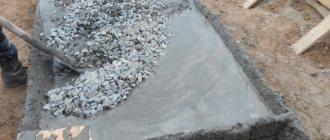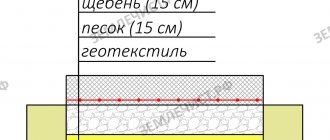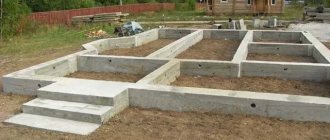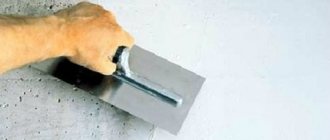When constructing multi-storey buildings, a foundation must be created. To fill the base, a special composition is made from gravel, crushed stone, cement, limestone, water, etc. It is recommended to buy ready-made solutions. about 2650-5150 rubles per cubic meter in Russia .
The service of ordering a foundation mortar machine is understood as a procedure during which the client orders from the company a certain amount of concrete of a specific brand with delivery to the construction site for a certain amount of money.
To pour the foundation for a house, a large amount of cement-sand mixture is required. Delivering the components of the composition and mixing them yourself is long and difficult. Therefore, many decide to order a car with a mixture for pouring the foundation of a house.
Pricing factors
The cost of a concrete machine may vary. The price is influenced by the following factors:
- Type of technology used.
- Delivery cost (mileage, type of fuel).
- Composition delivery radius.
- Type of mixture.
- Urgency of delivery.
- Pricing policy of the organization.
The final price consists of the following components:
- Cost of goods.
- Cost of delivery.
Varieties
Vehicles with foundation mortar are classified into two types:
- Mixers (working radius is 6 meters).
- Truck-mounted concrete pumps (unloads at a distance of up to 62 meters).
Gravel concrete is usually used to fill the foundation. It comes in the following brands:
- M100.
- M150.
- M200.
- M250.
- M300.
- M350.
- M400.
- M450.
- M550.
Depending on the capacity of the transport, you can order the product for:
- 7 cubic meters
- 9 cubic meters
- 10 cubic meters
- 15 cubic meters
You can buy concrete for the foundation of a house:
- At the factory.
- In small manufacturing plants.
- From resellers.
What does the cost of a foundation consist of?
Organizations that provide similar services to the public often announce on their websites the price of foundations for a particular structure. This is just an average figure designed to roughly guide a potential customer. When a specific project is drawn up, taking into account all construction conditions, the numbers can change either up or down.
This depends on a lot of various nuances, a list of which is presented below:
- Foundation type and configuration.
- Type of soil and its physical and mechanical properties.
- Complexity of the hydrogeological situation (presence of quicksand or work in conditions of high soil moisture).
- The structure of the preparatory layers (sand only, sand and crushed stone, construction of concrete footing or its absence), their thickness.
- The depth of the foundation base (the volume of soil removed depends on this).
- The concreting technologies used (especially varied when pouring piles).
- Terrain (stepped belts and slabs, high raised grillages are more expensive).
- The degree of mechanization of excavation work, because in certain conditions you have to dig manually.
- Types of formwork used: permanent, inventory, removable panel formwork.
- Basementless foundation or with a basement floor.
- The presence or absence of thermal insulation layers.
- The use of ready-mixed concrete or its production on the construction site.
The volume of excavation matters
Since the most important difference is the type of foundation, on which its material consumption depends, we will consider each category separately, taking into account the design features.
Tape
The popularity of strip foundations is due to the fact that they can be formed on clay soils, and in Russia they are the majority. If you do not take into account such extremes as high soil moisture, permafrost or significant subsidence, you can choose your own version of the tape for any occasion.
- For example, when the soil is hard and immobile, the tape can be made shallow or even superficial. In this case, its static nature is ensured due to the lattice structure: the outer beams along and across are combined with crossed inner ones, which entails an increase in volume. Such a tape will be cheaper due to the practically zero volume of excavation work.
- It happens that the surface layer of soil is soft or loose but shallow, and underneath there is a durable layer. In this case, the tape is laid to the mark of a durable compacted layer, and for stability, its base is widened due to a concrete pad 200 mm thick. Even if the volume of concrete spent here turns out to be no more than for a lattice surface tape, the price tag will increase due to the larger volume of soil removed, increased costs for formwork, and even the T-shape.
- Where soft and hard layers alternate to a considerable depth, the tape also has to be buried to the level of a layer that is reliable in terms of its load-bearing capacity. It takes the form of a wall in the ground, and in terms of concrete consumption it can even outstrip even the slab that is considered the most material-intensive. Accordingly, it will cost more.
Strip foundation for an extension
So, to say unambiguously how much it costs to pour a foundation in the form of a strip would be completely wrong. The cost of concreting is one thing, but the final cost of the structure is quite another. Although, of course, you can get your bearings - just go to the website of some organization engaged in the construction of turnkey foundations and make a preliminary estimate.
Expert opinion Vitaly Kudryashov builder, aspiring author
Ask a Question
We can take any size of the building, because we need to find out how much it costs to pour the foundation per cubic meter. If the filling will be done manually, you can simply calculate the cost under the “materials” section, without the cost of work.
Let's say you will build a house made of aerated concrete measuring 8 * 10 m on a shallow lattice foundation 60 cm high and 50 cm wide, with one longitudinal beam in the middle and two transverse ones. The total length of such a foundation will be 64 m, volume 19.2 m³ (rounded 20 m³). Here's what the calculation of materials with prices for April 2022 will look like:
| № | List of materials and works | Unit change | Quantity | Price, rub) | Amount (RUB) |
| Materials | |||||
| 1. | Geotextiles | m² | 120 | 46 | 5520 |
| 2. | Sand (delivery from the quarry) | m³ | 20 | 650 | 13000 |
| 3. | Crushed stone fr. 20-40 mm (delivery from the quarry) | m³ | 10 | 1450 | 14500 |
| 4. | Lumber 40*150*6000 mm for formwork | m³ | 4,6 | 14500 | 66700 |
| 5. | Working fittings АIII d=12mm | kg | 564 | 57 | 32148 |
| 6. | Knitting wire | kg | 23 | 95 | 2185 |
| 7. | Concrete B22.5 W6 F150 (delivery separately) | m³ | 20 | 3750 | 75000 |
| 8. | Consumables | set | 1 | 12000 | 12000 |
| Total materials: | 221053 |
Thus, if you do all the work yourself, a cube of foundation will cost 11,000 rubles. According to the same estimate, in the “works” section the final figure is 151,884 rubles, that is, the total cost of such a turnkey foundation is 389,937 rubles, which in terms of 1 m³ of foundation is about 19,500 rubles.
Note: The services of a hired team, which will dig trenches and pour concrete manually, will not be cheaper: manual pouring of concrete costs a little less than mechanized (1,600 versus 2,000 rubles), but digging soil with a shovel costs almost 2.5 times more (1,200 versus 500 rubles), so the game is not worth the candle.
It’s better to hire an organization that works using mechanisms - it will at least provide good quality.
Plitnogo
A slab foundation has no less variations than a strip foundation. It can not only be flat in shape, but also have stiffening ribs directed into the ground or towards the walls. Under the slab there may be concrete preparation or a very significant thickness of thermal insulation layer, which naturally cannot but affect the cost of the foundation.
If we do not take into account houses with a basement, for which the foundation needs to be laid to a great depth, the slab is always formed in a shallow version - or even superficial. Therefore, it does not cost much more than the lattice tape discussed in the previous chapter - or even cheaper.
Construction of a slab foundation
We calculated the materials for a 350 mm thick slab for the same house 8*10 m, and this is what we came up with:
| № | List of materials and works | Unit change | Quantity | Price, rub) | Amount (RUB) |
| Materials | |||||
| 1. | Geotextiles | m² | 120 | 46 | 5520 |
| 2. | Sand (delivery from the quarry) | m³ | 20 | 650 | 13000 |
| 3. | Crushed stone fr. 20-40 mm (delivery from the quarry) | m³ | 10 | 1450 | 14500 |
| 4. | Lumber 40*150*6000 mm for formwork | m³ | 0,8 | 14500 | 11600 |
| 5. | Working fittings АIII d=12mm | kg | 1443 | 27 | 82251 |
| 6. | AI fittings d=8mm for clamps | kg | 102 | 61 | 6222 |
| 7. | Knitting wire | kg | 58 | 95 | 5510 |
| 8. | Concrete B22.5 W6 F150 (delivery separately) | m³ | 28 | 3750 | 105000 |
| 9. | PVC membrane for waterproofing | m² | 96 | 160 | 15360 |
| 10. | Consumables | set | 1 | 12000 | 12000 |
| Total materials: | 270963 |
The volume of the foundation slab monolith turned out to be 8 m³ larger, but if we divide the total amount by 28 m³, we get 9,677 rubles - less per cubic meter than in the case of tape. If you carefully compare the tables, you can see that this difference is due to the price of lumber. The formwork of the slab is small, and the sides are placed not in two rows, but in one.
The cost of work on installing the slab, together with the delivery of concrete and building materials, according to this estimate amounted to 188,600 rubles. We divide the total amount of 459,600 rubles. for a slab volume of 28 m³, we get an average cost of 16,412 rubles/m³. Again, it turned out less than the tape, but here you will also have to lay out a brick base (no need for it on the tape), so in the end you will get the same or a little more. But the slab has practically no restrictions in its applicability, and it best ensures the spatial rigidity of the building.
Pile (columnar)
A pile foundation is a foundation constructed from vertical supports united into a single system by a surface looped beam - a grillage. Only wooden or frame houses can do without a grillage, in which this function is performed by the lower horizontal element of the log house or frame. Monolithic pillars can also be called piles. The only difference between them is that the pillars usually do not exceed 2.5 m in length, and they often have a widened base, and the piles can penetrate the ground to a considerable depth (12 meters or more).
In private housing construction, mainly one type of pile is used - bored piles. The popularity of this design is that it can be formed without the use of heavy drilling or driving equipment. Reinforced concrete piles with a grillage have a high load-bearing capacity, especially in seismically unfavorable areas, making it possible to build houses on the most problematic soils and difficult terrain.
The main thing is to correctly calculate the length of the piles, which requires a soil analysis, as well as the cross-section of vertical and horizontal elements, which depends on the expected loads. These nuances affect the cost of the foundation, as well as the height to which the grillage will be raised above the ground.
There are three options:
- High location. Such schemes are usually designed in areas with uneven terrain, when building on the shore of a reservoir, in areas with high snow cover or the likelihood of spring floods. The maximum distance of such a grillage from the planning ground level can be the height of a full floor - only it will be called a basement. In the standard version, the gap between the bottom of the grillage and the ground is 20 cm.
- Ground location. If the use of piles is dictated only by the hydrogeological situation on the site, and there are no problems with the terrain or high snow, it makes no sense to raise the grillage high. The ideal option would be a ground location, in which the mark of the bottom of the grillage coincides with the planning mark of the ground. And so that it is not affected by the forces of frost heaving, the mainland soil under the grillage is replaced with a sand cushion, or, as an option, insulation is laid in this place.
- Recessed grillage. Here, the lower plane of the grillage is below the surface of the ground, actually being a version of a strip foundation resting on piles. The scheme is quite rare and is used in conjunction with driven piles - only the first two methods are acceptable for bored piles.
Bored foundation with ground grillage
In low-rise housing construction, the option with a ground grillage is most often used - as the most economical. Let's consider how much the foundation for a stone house measuring 9*10 m will cost. The piles have a size of 2000 mm in length and 300 mm in diameter, the cross-section of the grillage is 800*400 mm.
| № | List of materials and works | Unit change | Quantity | Price, rub) | Amount (RUB) |
| Materials | |||||
| 1. | Film 120 micron | m² | 57 | 60 | 3420 |
| 2. | Sand for adding under the grillage | m³ | 7,52 | 1100 | 8276 |
| 3. | Rental of inventory grillage formwork | set | 1 | 47185 | |
| 4. | Transportation costs and special equipment | set | 1 | 16000 | |
| 5. | Asbestos cement pipe for casing wells D-300mm | PC | 9 | 3000 | 27000 |
| 6. | Concrete B22.5 | m³ | 24 | 4150 | 99600 |
| 7. | Hardware | set | 6177 | ||
| 8. | Working fittings A500 d=12mm | m/n | 605 | 42 | 25402 |
| 9. | AI fittings d=8mm for clamps | m/n | 362 | 21 | 7589 |
| 10 | Geotextiles | roll | 3 | 1000 | 3000 |
| Total materials: | 243649 |
If we calculate the cost of a cubic meter of a bored foundation, based on the cost of a set of materials, the costs turn out to be lower than for tape and slightly higher than for a slab (10,150 rubles). Taking into account the cost of the work performed, such a foundation measuring 9*10 m costs 401,308 rubles. Dividing by the volume of concrete, we get 16,721 rubles/m³, which is also less than in the case of tape, and slightly more than the cost of a floating slab.
The conclusion suggests itself: the slab foundation in the above-ground version is the most cost-effective.
Estimated cost
Approximate prices for machines with foundation mortar are shown in the table below.
| Concrete grade | The cost of a machine with a composition in rubles per cubic meter |
| M100 | 2300 |
| M150 | 2950 |
| M200 | 3100 |
| M250 | 3250 |
| M300 | 3350 |
| M350 | 3650 |
| M400 | 3850 |
| M450 | 4000 |
| M550 | 4150 |
The cost of delivering the composition for pouring the foundation of a building depends on the distance. Delivery prices are shown in the table below.
| Kilometers, km | Cost in rubles |
| to 10 | 350 |
| 10-15 | 400 |
| 15-20 | 450 |
| 20-25 | 500 |
| 25-30 | 550 |
| 30-35 | 600 |
| 35-40 | 650 |
| 40-45 | 700 |
| 45-50 | 750 |
| 50-55 | 800 |
| 55-60 | 850 |
| over | 900-1000 |
As a result, the price of a vehicle with concrete for pouring the foundation of a house will be from 2650 to 5150 rubles per cubic meter .
Work carried out
When ordering ready-mixed concrete, it is necessary to take into account that the dimensions of most mixer machines are designed to transport at least 20 m3. If you purchase a smaller volume of material, you will still have to overpay.
Approximate prices for the main construction areas related to concrete laying are presented in the table:
| Concrete works | Approximate price for 1 m3/1 m2 |
| Pouring, laying by machine | 640 |
| Concrete pouring, laying by hand | 2500 |
| Grinding | 200 |
| Arrangement of the foundation of a private house with a concrete thickness of less than 0.5 m | 2500 |
| Pouring a flight of stairs | 2500 |
| Installation of formwork | 1000 |
| Concreting terraces | 1500 |
| Concrete balcony | 2000 |
| Concrete floors in an apartment with a grinding machine | 1200 |
| Reinforced concrete floor | 1600 |
| Reinforcement | 800 |
Additionally, delivery to the construction site is added, the approximate cost of which ranges from 3000 to 4800 per m3. Workers charge up to 15 thousand rubles for pouring for 8 hours of work. Before accepting an order for work, the company providing the services must agree on the price for lifting concrete to a height if required by the project.










